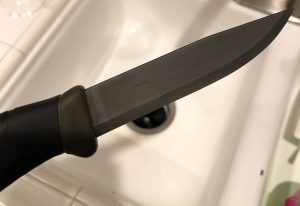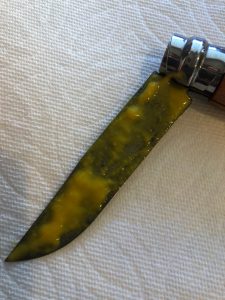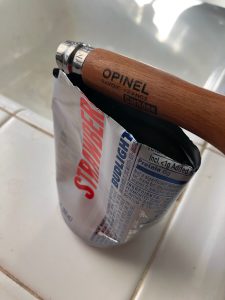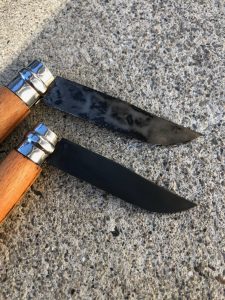 Many knife owners, including chefs, tout the benefits of carbon steel over stainless steel.
Many knife owners, including chefs, tout the benefits of carbon steel over stainless steel.
The main benefit being that it holds an edge longer.
While carbon steel has some advantages over stainless steel, one of it’s downsides is that it is prone to rusting.
Luckily, a patina on the blade can help minimize the possibility of rust.
This article is going to show you exactly how you can get a nice blue patina on your carbon steel blade.
What is a Patina?
A patina is a thin layer of oxidation on the surface of carbon steel.
The patina is similar to rust in that it is oxidation, but there are some differences and in fact it can help protect from rust.
What is the difference between a patina and rust?
The chemical composition of rust and the patina are similar but not quite the same. Both rust and the patina are a combination of iron molecules and oxygen molecules.
The patina is made from what is called Magnetite (Fe3O4). Hermite, or rust as most people know it, has a chemical formula of Fe2O3.
The difference in whether Hermite or Magnetite form has to do with the presence of water. If water is present, common brown/orange rust will form. If it is absent, you will get a layer of Magnetite.
The benefit of a patina is that it actually forms a protective layer than makes it less likely rust will develop on the carbon steel.
How to Get a Blue Patina on Carbon Steel
When you first start experimenting with forcing a patina on a blade, you should consider buying an inexpensive knife or two that you can experiment with.
This way you can figure out how to get the finish you want without risking a more expensive knife turning out poorly.
Our two favorite inexpensive carbon steel knifes are Morakivs and Opinel.
- BUSHCRAFT KNIFE: The perfect all-in-one knife for outdoor enthusiasts, this outdoor knife makes an ideal camping knife, backpacking knife, fishing knife, hiking knife, or survival knife
- PREMIUM BLADE: 0.08-inch thick 1095 carbon steel knife blade provides superior strength and stability with every cut
- HIGH-FRICTION HANDLE: Made with an ergonomic polymer handle with a soft friction grip and finger guard, this knife is safe and efficient for use in all weather conditions
Don’t be fooled by the price, both of these are excellent knives. The Opinel No. 8 is my preferred EDC and will be used for the following blue patina step by step.
- XC90 CARBON STEEL BLADE: Extremely hard thereby ing excellent cutting quality, good wear resistance, and easy regrinding. Carbon steel can corrode easily, maintain your knife by avoiding damp locations, and wipe and grease the Blade after use
- FLAGSHIP SIZE: The Number 8 is the most sold and versatile size in the ever-growing line of Opinel folding pocket Knives, earning its reputation as an everyday carry staple. 3.35” blade (8.5cm), open length 7.5” (19.5cm)
- PATENTED VIROBLOC: A hallmark of Opinel everyday carry knives since its invention in 1955, the Virobloc ring offers a unique, thoughtful, and easy to use safety mechanism for locking the blade during use, during Transport, and during storage
Step 1. Prepare the Blade
The first step is to prepare you blade for treatment. If it is a new knife, simply wipe the knife with some rubbing alcohol to remove any oils on the carbon steel.
Since this is a knife I have had for a while, I rubbed the blade with some Bar Keepers Friend to remove previous oxidation.

Step 2. Cover Blade in Mustard or Vinegar
The next step is to cover your blade with either mustard or vinegar. If you are using mustard, you will get more of a pattern that matches the spread of the mustard. You can try experimenting with using a sponge to blot the blade, giving it a cool design. Mustard will result in more a of a blue tinted patina.

If you use vinegar, you will submerse either part or all of the blade in a cup or can like shown. Vinegar will give more of a solid charcoal gray patina without much of a pattern. See pictures below for a comparison.

Step 3. Wait
Let the blade sit with the mustard or vinegar on it for a minimum of 20 minutes up to a few hours. The longer you wait, the more oxidation and deep coloring you will get.
We don’t recommend letting it go for more than a few hours as you may start to get heavy amounts of corrosion if you leave it on there too long.
Start out with shorter periods of time and see how you like the finish. You can always apply another coat of mustard or put the blade back in the vinegar.
Step 4. Clean Blade and Oil
When you are done, thoroughly clean the blade of the mustard/vinegar. You can rinse it off with water, just make sure to wipe it dry afterward.
Finally, wipe a thin coat of oil on the blade for extra protection. You can use gun oil, 3-in-1, or even cooking oil.

Here is a side by side comparison of a mustard patina (top) and a white vinegar patina (bottom).
Other Ways to Get a Patina
Naturally
If you just put the knife through regular use, it will naturally form a patina over time. This process usually takes a month or two. The colors are not as deep but it is more natural looking. Just make sure never to leave any water on the blade or it will rust.
Fruits
Another popular way to patina a blade is to cut up some fruit and let the blade sit for an hour or so before wiping the fruit juices off. Some commonly used fruits are apples, pineapples, and kiwis.
Potatoes
Although we haven’t tried it, we have heard of people sticking their knife in a potato and leaving it over night. The images we have seen result in a textured looking, light gray finish.
Related Questions
Is a patina safe?
A blade with a patina is completely harmless. It is common practice for chefs all around the world to prepare food with carbon steel knives that have a patina on them.

Will a patina prevent rust?
Having a patina will help but will not guarantee your blade does not rust. If water is left on the blade long enough, the blade will still eventually develop rust spots.
With that said, for every day use you will be must less likely to get any rust spots as long as you make sure to wipe your blade off after use.
How do you remove a the patina?
Removing a patina can be a bit tricky. Since the patina layer is just at the surface and not very thick, you want to try to use something that is just abrasive enough to remove the layer without doing any damage to the blade itself.
The best compound to do this is Flitz metal polish. It is light enough that it won’t do any damage to the blade.
If you are okay using something more abrasive, Bar Keepers Friend does a good job as well.
Whatever you do, don’t use sandpaper. Sandpaper will leave a ton of scratch marks on your blade that will be very difficult to remove.

